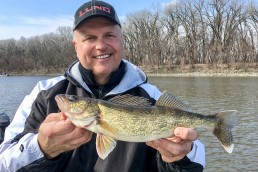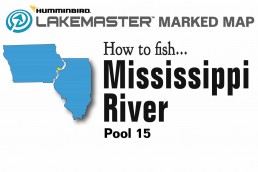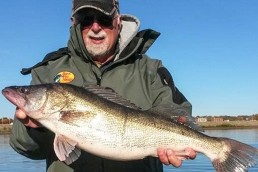Spring River Walleyes
SHARE THIS POST
“Ice!,” warned one of my fishing partners. “Got it,” I replied and swerved my Pro V to the right to avoid a chunk of ice floating down the river. A couple miles upstream from out boat launch, I throttled down the Merc and slowly approached a wing dam near a small inlet into the big river. This is one of my favorite spots on this particular river. There is a shallow flat near the shore, and then a quick drop to another flat before another sharp drop into the channel.
The flat closest to shore has a slow back current actually flowing upstream and the next flat out has a slow downstream current with a couple of dead spots with no current. All of this is upstream of the wing dam. We quickly got 3/8-ounce rattling jigs tipped with fathead minnows down just above bottom and pointed the boat into the slow current to use the bowmount MinnKota to slow and control the drift.
Almost immediately I felt a “thunk” on my jig and set the hook. After putting the 18-inch sauger in the livewell and dropping down another minnow, one of my partners called for the net. I dipped a 16-inch walleye for him and got back to fishing as the eye went into the livewell.
“How many are we going to keep?” asked one of my fishing partners. “Two or three small ones each?” I ran by him. “Here comes another one,” was the response and, seconds later, I dipped a 20-inch walleye. About ten minutes went by before I felt big weight on my jig and set the hook. “Don’t think this one is going in the livewell,” I said. It wound up taking me almost ten minutes to get the big catfish up to the boat. We netted it so we could get a photo, then I slid it back into the river. “That was fun,” I said. “Would have been more fun if it was a 10-pound eye,” was the reply from my net man. “Good point, but we are on the spot.”
March walleye madness
I love fishing big rivers in March and April. Depending on weather conditions, you can get a few weeks to a couple months of great fishing as walleyes make their annual spawning run upriver. Saugers, catfish, sturgeon on some rivers, and even pike can add some variety to your daily catch. You likely can find a river that walleyes run up in the spring relatively close to where you live in the Midwest.
In my home state of Minnesota, there are several areas on the Mississippi, St. Croix, Red, and Rainy rivers where walleyes run up to a dam and the areas below the dam to spawn in the spring. Many of these areas can get busy on the weekends in March and April, but the fishing action can be worth driving and fighting crowds. This time of year on rivers brings the opportunity to catch large numbers of fish, as well as big, fat, heavy female walleyes. I have had 100 fish days in my boat on the Rainy and Mississippi, and have caught fish up to ten pounds.
Walleyes will be scattered throughout rivers this year, but certain areas will concentrate fish more than others. The two main factors to consider when looking for walleyes on rivers in the spring are current and obstacles that stop migrating fish. On big rivers, walleyes will move upstream from pools or lakes until they run into an obstruction that stops them. Often this will be a dam. On smaller rivers, it could be a shallow rapids area the fish can’t swim through.
Are you enjoying this post?
You can be among the first to get the latest info on where to go, what to use and how to use it!
Once fish reach this obstruction, they will spread out to look for suitable spawning areas downstream of the obstruction. To find concentrated fish, either spawning or migrating to spawn, look for areas with less or no current. Areas below a lock, wing dams, inside bends of the river, wider areas with less current near shore, and areas where smaller rivers and streams enter the main river all can concentrate fish. Walleyes won’t spawn in too strong of current, and are looking for spots to rest out of the current on the migration and during the spawn. These spots with less current are also much easier to fish effectively.
Jig and minnow
There are lots of techniques that can be used to catch spring river run walleyes depending on the conditions, but day in and day out it is tough to beat the classic jig and minnow combination. This bait can be cast up onto shallow, slow-water shoreline flats. It can also be vertical fished below the boat along sharp breaks and in deep holes beneath the current in the main channel by simply increasing the weight to match the depth and current speed.
While a live minnow is often a good bet to tip your jig with, soft-plastic minnows or grubs shouldn’t be overlooked—especially when casting a jig shallow as live minnows can tear off easily after repeated casts. For casting shallow, I like a jig with the line tie on the nose. This type of jig moves through snags better and can be swam over them. A standard round-head jig works well for vertical fishing, but so does a flat-sided, teardrop-shaped jig as it drags less in current. A wide-gap hook is best for fishing with a live minnow, and a second line tie for a stinger hook is a good idea as well. I like jigs with rattles to help fish find the bait in the dirty, dark water of rivers in the spring, and bright-colored jigs are a good idea as well. One of my favorite color combinations for rivers in the spring is pink and chartreuse. Glow, chartreuse, orange, pink, and combinations of these colors are all good bets.
For vertical fishing a jig and minnow in moderate to slow current, I like to use my electric trolling motor to slow the boat’s drift. This allows me to fish the jig downstream of the boat, slightly, as the boat slowly moves downstream. This way, if the jig drops into a snag, I can pop it back out pulling it upstream to dislodge it before the boat’s movement drags it into the snag further. This boat control technique can be accomplished with a bow or transom mount electric motor, or a tiller gas engine. I try to keep the jig just off the bottom, lightly fluttering it to get the rattle going but keeping the bait relatively still for fish to find it in the low-visibility conditions. To hook the minnow on the jig, I like to run the hook point into the minnow’s mouth, back between the gills, and then up out of the top of the minnow behind the head through what I call the shoulders of the minnow. This holds the minnow on the hook fairly firmly, keeps the minnow in line with the jig, and doesn’t instantly kill the minnow so it hopefully struggles on the jig and attracts fish.
For vertical fishing a jig and minnow on a river, I use a 6-foot to 6-foot, 3-inch medium-power, fast-action spinning rod with a quality spinning reel spooled with 8-pound-test Berkley Fireline Crystal. The Fireline is thinner and drags less in the current. Its sensitivity allows you to feel a light bite or the jig banging into a snag instantly so you can react quickly and set the hook or pop it free. For casting jigs to shore, I will use a longer 6.5-foot or 7-foot rod with the same reel and line.
When the ice starts to weaken, think about getting out on a river in your area. This is an opportunity to get the boat out of storage even before your area lakes open up and to start fishing with a long rod for the first time in months. It is also a chance to catch large numbers of walleyes—with a shot at a true trophy fish—as well as some other species of fish present in your area river. Know how to locate where fish will concentrate, master a couple presentation techniques, and have a blast enjoying some of the first warmer weather in months.
MWO
SHARE THIS POST
Did you enjoy this post?
You can be among the first to get the latest info on where to go, what to use and how to use it!
Troy Smutka
Troy Smutka is a central Minnesota fishing guide (greatdayonthewater.com) and a walleye tournament angler. He is also a member of the Lund Boats, Mercury Outboards and Johnson Outdoors Pro Teams, and hosts and produces Fishing and Hunting the North Country on YouTube.



